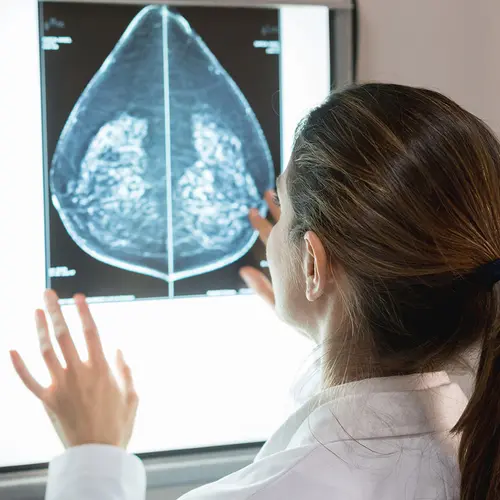Cording – also known as axillary web syndrome (AWS) – is a side effect of having lymph nodes removed as a result of breast cancer. A cord, or web of cords, develops under the skin on the inside of your arm. This rope-like tissue can be uncomfortable and make it difficult to use your arm normally, but there are treatments that can help.
How Your Lymph System Works
Your lymph system is part of your immune system. It consists of a network of lymph vessels – similar to a network of blood vessels – and lymph nodes – small glands.
The lymph vessels collect and drain extra fluid from your body. They also carry white blood cells to parts of the body where they are needed, in order to destroy invaders like viruses. As the lymph flows through the nodes, the nodes filter out damaged cells and bacteria.
Sometimes breast cancer can spread to your lymph nodes. Your doctors need to know if the cancer has spread so they can create the best possible treatment plan for you.
What Causes Cording?
Cording is a common side effect of the surgery in which lymph nodes are removed from the underarm area and tested to see if breast cancer is spreading.
There are two types of biopsy – an examination of removed tissue – that your doctor may recommend. For a sentinel lymph node biopsy (SLNB), two nodes are removed. For axillary lymph node dissection (ALND), many lymph nodes are removed.
Most people who undergo treatment for breast cancer must have one or both of these surgeries. Sometimes surgery to remove the cancer itself can cause cording or make it worse.
The more lymph nodes the surgeon must clear out, the greater the chance that you will have cording. However, cording can happen even if only one node is taken. When an axillary (underarm) lymph node is removed, the lymph vessels connected to it harden, leading to axillary web syndrome.
Signs of Cording
AWS typically appears within several days to several weeks after surgery. There have been a few cases where it didn’t start until months or possibly years later.
If you have cording, you may first notice pain in your armpit when you raise your arm over your head. A tightness will run from the surgery site down to your elbow or even your wrist. It may also run along your chest. Over the next few weeks, the cord or cords thicken until you can feel them and see them under your skin.
The tightness and pain of cording can make it difficult to raise your arm any higher than your shoulder or to extend your elbow all the way. This can make it difficult to do your normal daily activities. It is an even bigger problem if it happens at the same time you are doing radiation therapy, which requires you to lift your arm over your head.
Cording Treatments
Physical therapy is highly effective for easing AWS. Symptoms usually go away within a few therapy sessions, or at least within a few months. Ask your doctor for a referral to a therapist, nurse, or doctor who has a lot of experience with cording.
Some or all of the following options may be part of your treatment plan:
Stretching exercises. The key to recovery is consistently doing special exercises that stretch the cords and allow you to move your arm more freely and with less pain. A physical therapist can teach you the exercises and tell you how often you should do them at home.
Pain medication. The exercises can be uncomfortable. You may need to take pain medication before therapy or exercise.
Swimming. Swimming can help you regain movement and lessen your pain and discomfort.
Laser therapy. Your therapist may use a small device to send low-level laser beams to the cords. This can help break down the scar tissue.
Manual therapy. Massage can help soften the cords. Your therapist may gently pull on the tissue in your arm, starting in the upper arm and working down toward your wrist. This may cause a cord to snap with a popping sound. It doesn’t usually hurt if this happens, and it might help you to move your arm more freely.
When a cord releases in one particular area, that part of your arm will probably feel better. Another part of your arm might then feel even tighter and more painful. That doesn’t mean that the AWS is getting worse. It just means those spots are still stuck. The pain will ease once the cord in that area is also released.
Even after your symptoms are gone, continue with your stretching exercises to keep your shoulder in good condition as you complete your breast cancer treatments and recovery.

